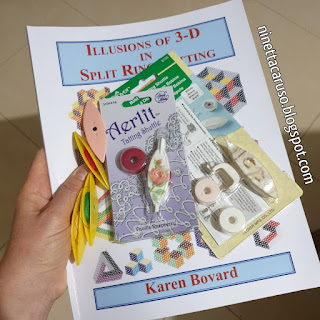I was very confused about the English terminology (the two terms bobble and bauble are both used by tatters), then I had an enlightening comment by J.Connors who cleared that, actually,... they mean the same thing! Phew!
Even though the population of mice kept growing on this site: https://janeeborall.blogspot.com/p/exclusive-tatting-club.html, I wasn't sufficiently attracted to try it, till a couple of weeks ago... In fact, that is when the challenge in "tatting a beaded rope" started.
But first, I needed to learn the basis.
The two primary source that worked for me are:
- http://janeeborall.freeservers.com/TipsBaubleBobble.html
- Karen Cabrera's Lesson 148 (https://youtu.be/1gRbL8Wj95E)
I learned that the technique is one, but the result looks different, depending if you tat with the starting ring away from you or toward you (or, in other words, if you tat the bauble clockwise or counter-clockwise):
The following two samples of mine are tatted with the same stitches' count and the same number of "sbt" (that means "stabilising thread"): 4 double stitches between 4 sbt.
The effect is very different, you see my samples in next pic, the yellow is tatted with the starting ring toward you, the red is tatted with the starting ring away from you:
For trying the "Demmer's" tatting beaded rope, I thought that the red one was the best, more stable and compact.
Sigh! I had trouble getting the beads nicely placed! That was because I wanted them put in column (there's more than one possibility to stack beads! Note to myself: try to vary the stitches' count between beads).
The rounded shape of my beads and the height of the double stitches, at first, didn't get along.
I used rocailles glass beads 9/0 and DMC Cebelia size 10. The beads in columns, put on picots, have their rounded side close to each other and they slip a lot.
In fact, when you put a bead on the picot, the bead has the hole aligned with the picot's thread. That is a problem when stacking beaded chains, tatting it becomes very cumbersome. This is my drawing for a bead on a picot.
So, they always say, new problems lead to new solutions.
Eventually I found a way to "twist" the beads so that they can be easily stacked.
I load beads on the ball thread and slide them on the picot, as usual. But after the first half stitch (picture1), I move the ball thread from right to left, in front of the bead, so that the picot thread is behind the bead (picture 2). Then I tat the second half stitch (picture3).
That makes the trick:
I'm calling this way: the bead "face-up" on picot. I hope that another drawing can help.
And here it is a picture with the "normal way" (on the right) and the beads "face-up" on picots (on the left):
The beads put in that position make the rope easy to tat, because they are stacked in column on their flat face.
For the tatting beaded rope in the first picture, I used a loom beading pattern, with 12 beads in each round, 4 sbt, the pattern is just a long line of one bead "face-up" on picot, then one double stitch, then repeat forever (or till you fall asleep). Dotted lines in my drawing are where I chose to insert the 4 sbt. All beads are loaded on the ball thread (named SH2 in the drawing).
Demmer's bobble is a very original and clever technique, the outcome of a nonconformist mind.
Roberta is also the name of a dear friend of mine, we met in our twenties and we are still in touch, even if we live very far from each other. She's been always nonconformist, a free spirit. Now I think the name has something to do with it.
How many other different techniques are there for tatting a beaded rope? I'll tell you in a week...
Ciao,
Ninetta























